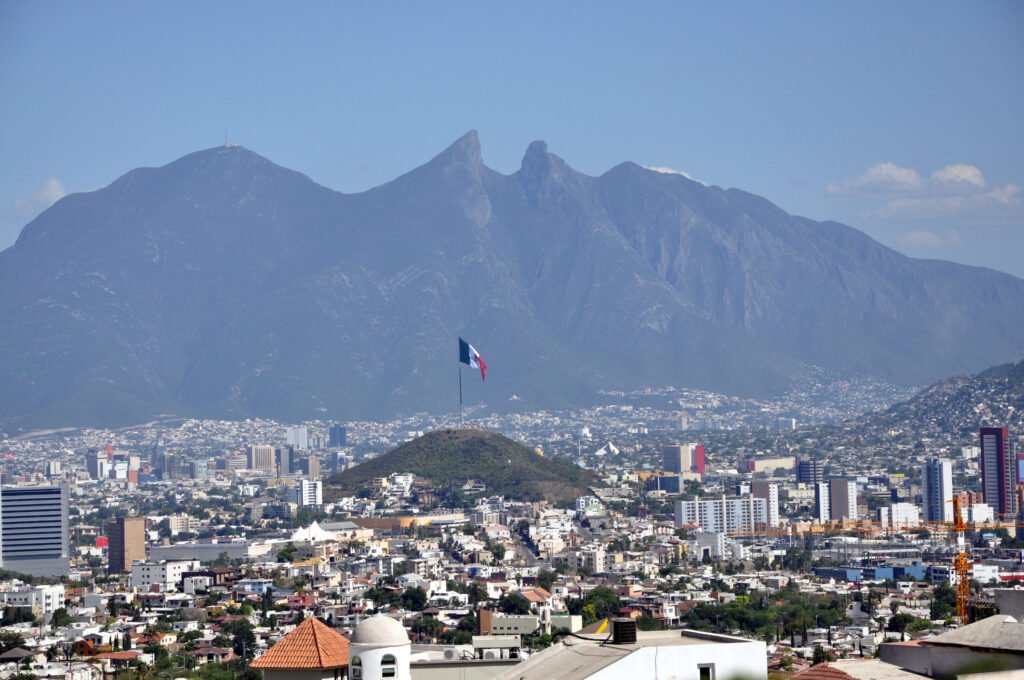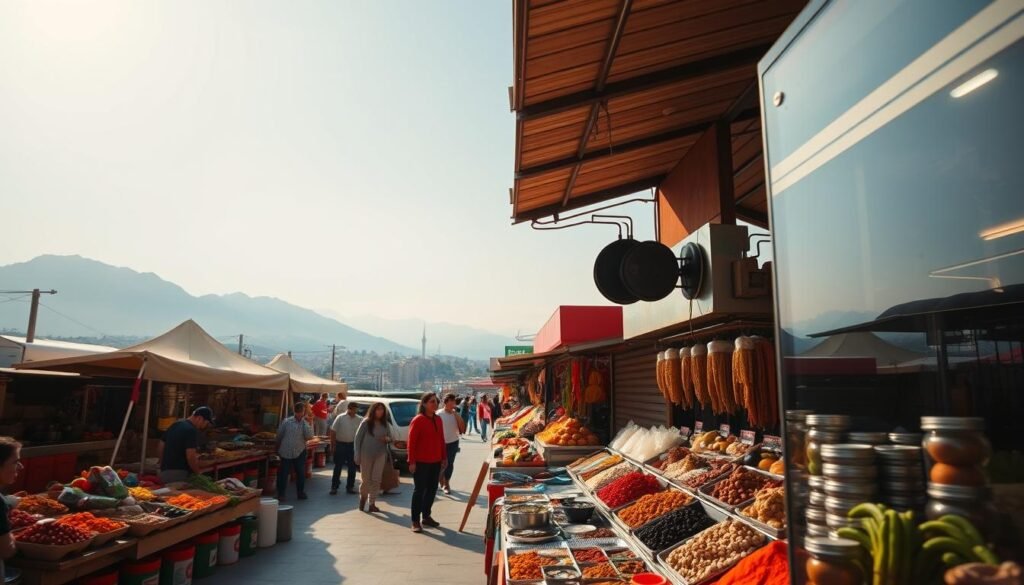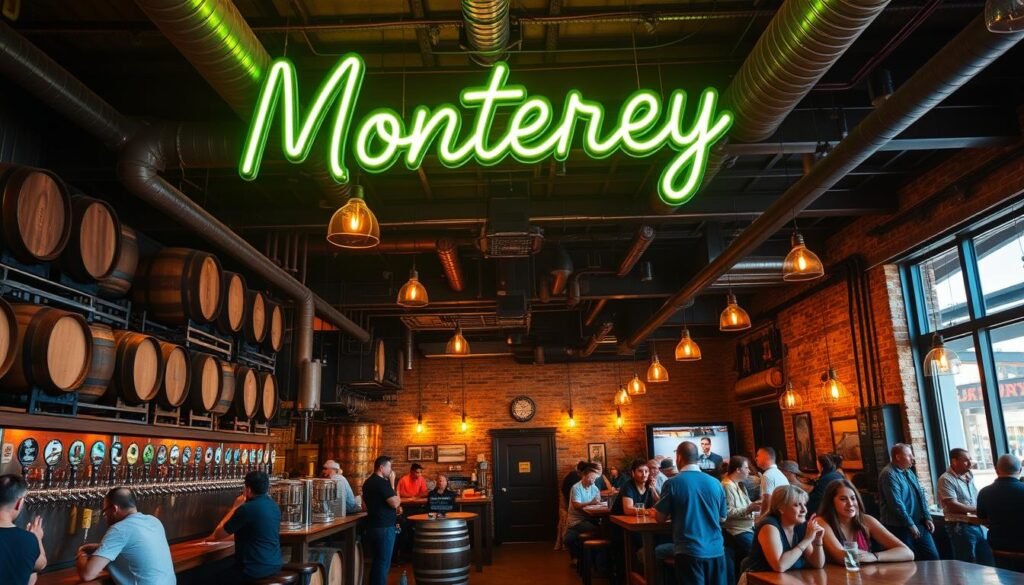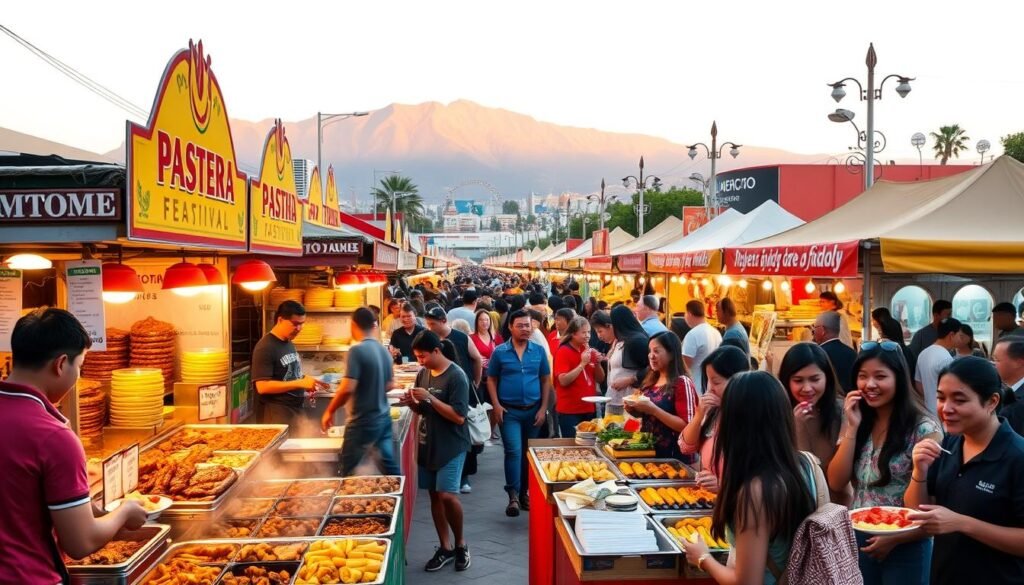My journey into northern Mexico’s culinary heart began in Monterrey. Here, steel mills and modern skyscrapers meet the sizzle of street carts. They serve al pastor tacos that are a must-try.
Culinary travel to Monterrey shows a food culture full of bold flavors. Think charred meats kissed by mesquite smoke and fresh tortillas. These are made in family-owned mills. Every bite tells a story of terrain and tradition.
Monterrey is more than just an industrial hub. Its food scene is vibrant and full of life. The city’s culinary identity is a mix of Spanish, indigenous, and ranching heritages.
At Mercado Hidalgo, I found out how regional staples like cabrito al pastor and chile con queso dip are more than just dishes. They are living testaments to the region’s history. Monterrey’s food culture invites travelers to explore beyond tacos al pastor. It offers a table where tradition meets bold experimentation.
Key Takeaways
- Monterrey redefines northern Mexico’s culinary identity through its fusion of rustic traditions and modern techniques.
- Authentic Mexican cuisine in Monterrey emphasizes locally sourced ingredients like Oaxaca cheese and smoked chiles.
- Culinary travel to Monterrey reveals a gastronomy shaped by its rugged landscape and ranching legacy.
- The city’s street food and high-end restaurants share a common thread: respect for centuries-old cooking methods.
- Northern Mexico gastronomy here bridges humble origins with inventive presentations, creating a dining experience unlike any other.
Why Monterrey Deserves Recognition as Mexico’s Northern Culinary Gem
Monterrey’s steel mills and modernity hide a culinary awakening. Smokestacks and sizzling pans coexist. Innovation turns traditional flavors into modern masterpieces, making Monterrey a top culinary spot in Mexico.
The Industrial City’s Unexpected Gastronomic Renaissance
Steel and progress fuel more than just industry here. Economic growth has sparked a passion for trying new things. Restaurants now mix aged beef with local herbs, and family recipes become avant-garde menus. This rebirth shows pride in northern Mexico’s food traditions.
Beyond Tacos: The Sophisticated Food Scene of Regiomontanos
Regiomontano cuisine goes beyond street food. People enjoy dishes like barbacoa de borrego in modern places. Chefs mix chile-based sauces with global methods. This blend makes Monterrey a hidden gem, unlike Mexico City or Oaxaca.
Learn how international influences inspire local chefs. Yet, they respect traditional methods. The result is a cuisine that’s both global and deeply rooted in local culture.
How Monterrey Differs from Traditional Mexican Culinary Destinations
Oaxaca loves mole, and Mexico City is all about street tacos. But Monterrey is known for bold charred meats and flavors. Think slow-cooked cabrito versus quick tacos. The northern Mexico food scene here is all about contrasts—smoky carne al carbon and vineyards in the foothills. This makes Monterrey a must-visit for those looking for something different.
The Rich History Behind Monterrey’s Unique Flavor Profile
Walking through Monterrey’s Mercado Hidalgo, I learned about the city’s food history. Vendors with family ties shared stories of Monterrey food history for generations. Each dish here tells a story, like the smoky scent of mesquite-grilled cabrito.
This scent whispers of northern Mexican culinary traditions from ranching life. My journey showed how regional food heritage mixes Indigenous, Spanish, and European influences. This mix creates today’s Mexican flavor profiles.

| X |
| X |
| X |
| X |
“This land’s flavors are written in smoke and wheat,” said Doña Rosa, a third-generation cook, as she shaped flour tortillas by hand. “We didn’t have corn here—so we adapted.”
Three forces shaped this identity:
- Indigenous Raramuri tribes introduced nopal and goat herding
- Spanish colonizers brought wheat, beef, and charcoal-cooking techniques
- 19th-century German and Lebanese immigrants infused spices and dairy into dishes like arrachera steak
| Cultural Layer | Legacy Ingredient | Modern Dish |
|---|---|---|
| Indigenous | Nopal cactus | Cabrito al pastor |
| Spanish | Flour | Tortillas de harina |
| European | Beer brewing | Local craft cervecerías |
Today, northern Mexican culinary traditions blend old and new. Tender goat meat meets crisp flour tortillas. Smoky char marks every bite of carne asada. This is where Monterrey food history comes to life.
Meat Lover’s Paradise: The Carnivorous Heart of Northern Mexican Cuisine
My first bite of cabrito al pastor in Monterrey was amazing. The skin was golden and crispy, revealing meat so soft it felt like butter. It was smoky from being roasted over charcoal. This shows Monterrey’s love for meat, making it more than just food.
Cabrito al Pastor: A Ritual of Flavor
Cabrito al pastor comes from 15th-century Jewish traditions. Families like those at Casa de Cabrito La Tradición have made it famous. They roast kid goats over mesquite until the meat is incredibly tender.
Every bite tells a story of family and tradition. Tacos de cabrito, with crispy meat on corn tortillas, are a favorite.
Carne Asada Traditions: Fire, Family, and Fellowship
Weekends in Monterrey are for carne asada. Butchers pick the best cuts, seasoned with salt and fire. “The best carne asada isn’t just cooked; it’s lived,” says Doña Rosario.
This dish is more than food. It brings families together at lively weekend asados.
Ranching Legacies Reimagined
| Traditional | Modern Innovations |
|---|---|
| Open-pit barbecues | Sous-vide marinated cuts |
| Family-run ranches | Chef collaborations |
| Hand-carved meats | Molecular gastronomy techniques |
In Monterrey, old traditions meet new ideas. At El Gran Charco, chef Carlos Méndez uses ancient ways to roast moncholo. La Cava 1884 adds modern spices to barbacoa. This mix of old and new makes every bite special.
From Street Food to Fine Dining: Navigating Monterrey’s Culinary Landscape
Monterrey’s food journey starts in its streets. Monterrey street food is more than just food; it’s a discovery ritual. Every corner in Barrio Antiguo offers flavors that share ancient stories.
Barrio Antiguo’s Hidden Food Treasures
Behind secret doors, vendors make gorditas that melt in your mouth. On Sundays, the smell of menudo fills the air. This dish, made with tripe, epazote, and chili, is a tradition passed down through generations.
San Pedro Garza García: Where Luxury Dining Meets Traditional Flavors
In another part of the city, San Pedro Garza Garcia restaurants mix old with new. Chefs at Epicurean-escape blend saffron-infused barbacoa with modern twists. Their menus celebrate traditional dishes like carne seca and mesquite-smoked flavors, served in stylish settings.
The Markets That Every Food Enthuasiast Must Visit
Colorful stalls overflow with prickly pears and chili pastes. Nearby, Mesón Estrella’s tortilla makers work with skill passed down through generations. These markets are not just places to shop; they’re schools where every bite is a lesson.
- Mercado Juárez: A kaleidoscope of regional produce
- Mesón Estrella: A 19th-century market alive with tortilla artistry
Whether you’re following the smell of al pastor or debating mole recipes, Monterrey’s food is worth exploring. It invites you to wander, street by street, and dish by dish.
Essential Culinary Travel to Monterrey: Creating Your Food Itinerary
Planning a Monterrey food tours adventure means finding a mix of old and new. I’ve created a culinary itinerary Mexico that includes both hidden spots and famous places. Each dish tells a story, making every bite memorable.

Start your day at panaderías like La Rosita, where pan de semita is baked in wood-fired ovens. My food travel planning list includes:
- Day 1: Begin at Mercado Hidalgo in the morning. Try guisos from vendors who’ve been there for years.
- Day 2: Have lunch at El Cielito for delicious barbacoa. Enjoy the sunset from La Cava’s rooftop.
- Day 3: For dinner, head to La Concha Náutica. The smell of grilled machaca fills the air.
| Day | Morning | Afternoon | Evening |
|---|---|---|---|
| 1 | Panaderías & Mercado Hidalgo | Winery tours in Santa Catarina | Taco stalls at Plaza de Toros |
| 2 | Ranch-style breakfast at El Puesto | Street food in Abastos Market | Fine dining at Mantequilla |
| 3 | Family-run carnicerías for cooking classes | Visit Casa de la Música for live music & horchata | Cocktail bars in Colonia Roma |
Follow the local beat: get to La Tía early for cabrito before it gets busy. Listen to street vendors and the best restaurants in Monterrey that mix history with new ideas. Your culinary itinerary Mexico is a flavorful journey through tradition and land.
The Influence of International Cuisine on Monterrey’s Food Evolution
Walking through Monterrey’s streets, you smell wheat-based breads and asado. This mix shows how European influence on Mexican food is part of Monterrey’s taste. Local kitchens tell stories of settlers who brought their traditions to this land.
German immigrants brought pan de cebada, a dense rye bread. Italian migrants helped create empalme sandwiches, mixing Middle Eastern pitas with local meats. These dishes are unique, blending old traditions with new ideas.
“We use foreign techniques but cook with local ingredients,” said Chef Elena Méndez of La Tropicalesa. Her ceviche mixes Japanese sashimi with nopal cactus.
- Traditional cabrito gets a French twist with herb-infused braising
- Mediterranean herbs like oregano and thyme flavor barbacoa tacos
- Modern Monterrey fusion cuisine restaurants like El Granero 28 serve kimchi-inspired chile-stuffed chorizo
Today, international food in Monterrey is more than just flavors. It’s a culinary evolution Mexico sees, with chefs like Diego Sánchez making machacado con huevo with Portuguese bacalhau. This mix of old and new shows Monterrey’s spirit: a place where tradition and innovation meet.
Beverages That Define Monterrey: From Craft Beer to Regional Spirits
Monterrey’s drink scene is more than just a way to stay hydrated. It’s a journey of taste and tradition. The city’s northern Mexican drinks and regional spirits Mexico are as rich as its food. Every sip is a new adventure.

The Craft Beer Revolution Taking Over the City
Old factories now smell like toasted barley. Monterrey craft beer makers mix local tastes like prickly pear into their brews. At a lively taproom, a brewer said,
“We add desert sage to our amber ales—terroir in every sip.”
These beers are more than drinks; they’re a taste of the desert.
Traditional Drinks With Modern Twists
- Carajillos get a twist: espresso with chile-infused brandies.
- Seasonal agua de Jamaica with hibiscus and ginger, found in carts and fancy bars.
- Pecan-honey horchata, a tribute to northern orchards, served in stylish glasses.
Wine Culture in Unexpected Places
Wine bars in hidden alleys offer regional spirits Mexico like agave vodkas and Coahuila’s Cabernet Sauvignons. Try a barrel-aged mezcal liqueur and see how terroir changes flavors. It’s a surprise in a region known for beef.
Monterrey’s beverage culture is its heart and soul. Every drink, from tangy tepache to smoky raicón, invites you to enjoy and explore.
Seasonal Delights: When to Visit for Signature Food Festivals
Visiting Monterrey at the right time turns meals into unforgettable memories. Spring’s Monterrey food festivals like the Expo Ganadera celebrate ranching traditions. They feature cabrito al pastor competitions. Autumn’s Festival del Queso y el Vino pairs aged cheeses with local wines, a highlight of northern Mexico food celebrations.
| Season | Event | Highlights | Signature Dishes |
|---|---|---|---|
| Spring | Expo Ganadera | Ranching heritage exhibitions | Cabrito al pastor, barbacoa |
| Summer | Feria de la Enchilada | 50+ enchilada variations | Enchiladas con picadillo, enchiladas de chile colorado |
| Autumn | Festival del Queso y el Vino | Local cheese pairings | Queso de bola, vinos de Cerveza Cuauhtémoc |
| Winter | Encuentro de Tamales Norteños | Handmade tamale workshops | Tamales de charales, tamales de huitlacoche |
Each season brings its own flavors to Mexican cuisine. Summer’s Feria de la Enchilada fills the air with smoky grill smells and chorizo samples. Winter’s tamale stalls use corn husks, a nod to regional identity.
- Book lodging early for Expo Ganadera (March) to enjoy cabrito at its best.
- Summer’s Feria de la Enchilada (August) showcases regional variations like cheese-stuffed enchiladas.
- Autumn’s wine pairings at the Queso y Vino Festival highlight northern Mexico’s emerging terroir.

Visit local markets like Mercado de Abelardo L. Rodriguez to see where ingredients come from. The city’s culinary scene follows nature’s cycles. Rainy seasons bring indoor fondue dinners, while summer’s heat fuels outdoor barbacoa feasts.
The Local Chef Revolutionaries Reshaping Monterrey’s Gastronomic Identity
In Monterrey, chefs are mixing science with art. They come from engineering, business, and family cooking backgrounds. They’re changing what northern Mexican food can be.
They mix traditional recipes reimagined with new techniques. This shows Monterrey’s innovative Mexican cuisine is getting noticed.
Interviews with Pioneering Culinary Artists
Guillermo González Beristáin of Pangea talks about how his engineering skills help him in cooking. He says, “Precision shapes creativity.”
He turns chile con queso into creamy foams. This shows how Monterrey restaurant innovators make regional ingredients shine. Chef Ana María Sánchez, a former corporate strategist, uses data to create dishes. She mixes smoky machaca with modern cooking methods.
Traditional Family Recipes Finding New Expressions
These chefs turn family recipes into art. They take dishes like dried beef croquettes and charro beans to new heights. One chef said, “
“We honor the past but let the ingredients speak in new dialects.”
They make dishes like cabrito modern with crisp verjus or smoked quince. This shows tradition can evolve, not disappear.
How Monterrey’s Cuisine Reflects Its Bold, Industrious Spirit
Walking through Monterrey’s bustling plazas, you feel the Monterrey food culture alive. It shows the northern Mexican character in dishes that are simple yet deep. Like charcoal-grilled meats cooked for hours, a tradition from the ranching days.
This food is made with care, patience, and a focus on letting flavors grow. It’s a testament to the value of time and effort in cooking.
A chef once told me, “Our kitchens are like foundries—transforming raw materials into something enduring.”
The city’s industrial city gastronomy reflects its history. It’s efficient yet creative. Family-run taquerías press tortillas with hands that once worked on assembly lines.
Modern chefs also bring new twists to old favorites like arrachera. They use smoked paprika and serve in old factory spaces. This mix of tradition and innovation is what makes Mexican culinary identity in Monterrey so unique.
- Resourcefulness: Braiskettas (chicken-stuffed tortillas) were made by migrant workers for easy, filling meals.
- Family legacy: Places like La Loma’s Carnicería keep old recipes alive while using sustainable methods.
- Innovation: Cervecería Cuauhtémoc combines old brewing ways with local ingredients in their beers.
In Monterrey, food tells a story of strength and elegance. Every bite of slow-roasted cabrito or charred asado de boda shows a city built on hard work. Now, it’s redefining northern Mexican cuisine.
Conclusion: Why Every Serious Food Traveler Should Journey to Northern Mexico’s Kitchen
My trip through Monterrey’s food scene changed how I see Mexican food. This place in northern Mexico is more than a stop; it’s a discovery. Every meal here is a mix of old and new, with dishes like cabrito and craft beer.
Carne asada here is more than meat; it’s a celebration of ranching traditions. The flavors, from markets to fancy restaurants, show the depth of Mexican food. It’s where tortillas and wine tell stories of strength and change.
Monterrey is a gateway to Mexico’s true food soul. Its dishes are bold and simple at the same time. Ready to explore? Let Epicurean-Escape guide you through northern Mexico’s food heart. Here, tradition meets adventure, and every bite is a new discovery in Mexican food.


